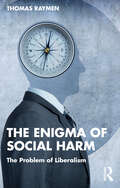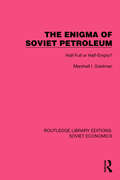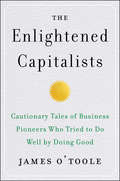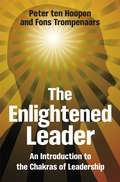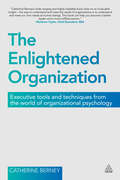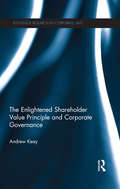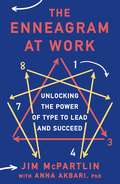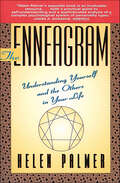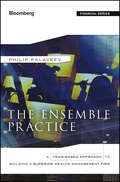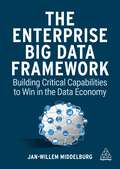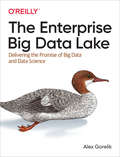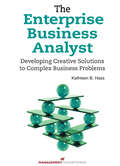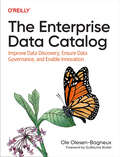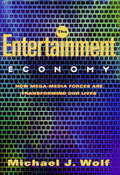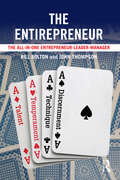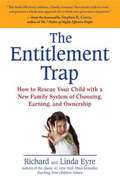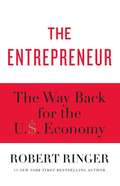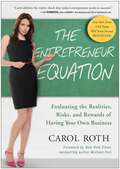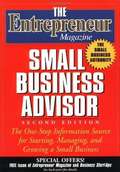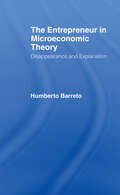- Table View
- List View
The Enigma of Social Harm: The Problem of Liberalism
by Thomas RaymenDrawing on a novel blend of moral philosophy, social science, psychoanalytic theory and continental philosophy, this book offers up a diagnosis of contemporary liberal capitalist society and the increasingly febrile culture we occupy when it comes to matters of harm. On what basis can we say that something is harmful? How are we supposed to judge between competing opinions on the harmfulness of a particular behaviour, practice, or industry? Can we avoid drifting off into relativism when it comes to judgements about harm? In an age of deep cultural and political discord about what is and is not harmful, providing answers to such questions is more important than ever. Appraising the current state of the concept of social harm in academic scholarship and every-day life, Thomas Raymen finds a concept in an underdeveloped state of disorder, trapped in interminable deadlocks and shrill disagreements about what should and should not be considered harmful. To explain the genesis of this conceptual crisis and identify what we need to do to resolve it, The Enigma of Social Harm travels from Graeco-Roman antiquity to the present day, exploring trends and developments in moral and political philosophy, religion, law, political economy, and culture. Along the way, we see how such trends and developments have not only made it more difficult to establish a shared basis for evaluating harm, but that the tools which might enable us to do so are now outright prohibited by the political-economic, cultural, and ethical ideology of liberalism that dominates contemporary society. Written in a clear and accessible style, it is essential reading for all those interested in matters of social harm, justice, politics, and ethics.
The Enigma of Soviet Petroleum: Half-Full or Half-Empty? (Routledge Library Editions: Soviet Economics #7)
by Marshall I. GoldmanThe Enigma of Soviet Petroleum (1980) provides an analysis of the relevance of the Soviet planning system to oil production levels: why it is that planning has been the source of so many petroleum industry problems, and the nature of the measures that are being taken to overcome them. It looks at the demand for petroleum in the USSR, and the discovery of new Soviet oil fields to furnish this demand.
The Enlightened Capitalists: Cautionary Tales of Business Pioneers Who Tried to Do Well by Doing Good
by James O'TooleAn expert on ethical leadership analyzes the complicated history of business people who tried to marry the pursuit of profits with virtuous organizational practices—from British industrialist Robert Owen to American retailer John Cash Penney and jeans maker Levi Strauss to such modern-day entrepreneurs Anita Roddick and Tom Chappell. <P><P>Today’s business leaders are increasingly pressured by citizens, consumers, and government officials to address urgent social and environmental issues. Although some corporate executives remain deaf to such calls, over the last two centuries, a handful of business leaders in America and Britain have attempted to create business organizations that were both profitable and socially responsible. In The Enlightened Capitalists, James O’Toole tells the largely forgotten stories of men and women who adopted forward-thinking business practices designed to serve the needs of their employees, customers, communities, and the natural environment. They wanted to prove that executives didn’t have to make trade-offs between profit and virtue. <P><P>Combining a wealth of research and vivid storytelling, O’Toole brings life to historical figures like William Lever, the inventor of bar soap who created the most profitable company in Britain and used his money to greatly improve the lives of his workers and their families. Eventually, he lost control of the company to creditors who promptly terminated the enlightened practices he had initiated—the fate of many idealistic capitalists. <P><P>As a new generation attempts to address social problems through enlightened organizational leadership, O’Toole explores a major question being posed today in Britain and America: Are virtuous corporate practices compatible with shareholder capitalism?
The Enlightened Leader
by Fons Trompenaars Peter Ten HoopenWith the stunning public cases of leadership gone awry, the search is on for a type of leadership that incorporates human values in an otherwise exploitative business world. In this book, the authors take the scalpel and address deeply ingrained nefarious management theory, and show the way to healing, opening fresh fields of ambition, new degrees of passion, and creativity. A synthesis of the best Western thinking and Eastern wisdom teachings, the book introduces "The Chakras of Leadership," a model of leadership that differentiates seven levels of human energy use.
The Enlightened Organization
by Catherine BerneyThe Enlightened Organization is concerned with the organization and its responsibility for enabling success by putting in place processes (including leadership and communication) that will enable it to thrive and grow. More specifically, it addresses the role the individual leader can play in building an enlightened organization, providing specific tools and techniques that executives can use to see more clearly into the heart of what matters in any given business situation; to learn to use their values, passions and beliefs as a powerful resource in the workplace; and to create authentic dialogue within the organization. Author Catherine Berney is an expert in organizational psychology: she draws upon this background to explore the business context of complexity and change and to present the models that can help organizations respond proactively in the current operating environment.
The Enlightened Shareholder Value Principle and Corporate Governance (Routledge Research in Corporate Law)
by Andrew KeayThe enlightened shareholder value principle (ESV) was formulated during the comprehensive review of UK company law by the Company Law Steering Group in the late 1990s and early 2000’s and requires directors of companies to act in the collective best interests of shareholders. The principle was taken up by the then UK Government and is now embedded in the Companies Act 2006. The emergence of the principle constitutes an important development in corporate governance, particularly in determining what directors must consider when managing the affairs of their companies. This book explains and analyzes the nature of ESV and its contribution to corporate governance whilst also examining where it fits into the existing theoretical landscape. Andrew Keay traces the development of the principle of ESV and considers it in the context of the existing principles which have historically influenced corporate governance. In doing so, the book draws on several empirical studies thereby enabling us to gauge how the ESV principle is addressed in commercial practice. Keay goes on to compare ESV with the constituency statutes that apply in the US in order to determine whether anything can be learnt from the American experience. The book also assesses the reaction of other jurisdictions to the advent of ESV and considers what impact ESV will have on financial institutions and non-financial institutions in the aftermath of the global financial crisis.
The Enneagram at Work: Unlocking the Power of Type to Lead and Succeed
by Jim McPartlinUse the power of the Enneagram to become a more effective, capable leader The Enneagram at Work is the first book to harness the insight of the Enneagram to transform leadership in today’s workplace. A veteran of the high-profile hospitality industry with two decades of experience working with the Enneagram, author Jim McPartlin has seen firsthand the way self-awareness can radically transform leadership, strengthen teams, and spark creative solutions. From giving and accepting criticism to fostering strong mentorships and managing conflict, The Enneagram at Work will give you invaluable tools for growing and thriving in your career. For the longtime Enneagram fan or those who are just learning to identify their type, The Enneagram at Work helps readers explore the full breadth of their type, becoming aware of their blindspots in the workplace and leaning into their strengths more fully. Each chapter includes actionable exercises and practices so that readers can move from learning to doing and apply their insights in the real world.
The Enneagram: Understanding Yourself and the Others in Your Life
by Helen PalmerIt would be impossible for most of us to spend a day without coming into direct or indirect contact with dozens of people family, friends, people in the street, at the office, on television, in our fantasies and fears. Our relationships with others are the most changeable, infuriating, pleasurable and mystifying elements in our lives. Personality types, based on the ancient system of the Enneagram, will help you to enjoy more satisfying and fulfilling relationships in all areas of your life by introducing you to the nine basic personality types inherent in human nature. This knowledge will help you better understand how others think and why they behave as they do, as well as increasing your awareness of your own individual personality. Written by the leading world authority on the Enneagram, it offers a framework for understanding ourselves and those around us, as well as a wealth of practical insights for anyone interested in psychology, counselling, teaching, social work, journalism and personal management.
The Ensemble Practice
by Philip PalaveevA detailed road map for wealth managers who want to build an ensemble firm or team and achieve sustained growth, profitability and high valuations Why do ten percent of wealth management firms grow faster than the rest of the industry, often despite the turbulence of the markets? The answer, according to industry consultant and researcher, P. Palaveev, is that the most successful firms are those which, create and promote a team-based service model that serves as the foundation of their enterprise. Find out how and why a team-based service model can play a decisive role in the future growth and sustained success of your wealth management firm Discover the key factors for building a successful ensemble firm and profit from the best practices top team-based firms employ Profit from the author's years of experience working with the world's top wealth management firms and the data he has compiled as a pre-eminent industry researcher Learn about the various organizational structures, partnership models and career path options and how to put them to work building an ensemble practice Get the lowdown on how the savviest traditional broker-dealer firms have formed dynamic ensemble teams within their organizations and learn of the results they've achieved
The Enterprise Big Data Framework: Building Critical Capabilities to Win in the Data Economy
by Jan-Willem MiddelburgBusinesses who can make sense of the huge influx and complexity of data will be the big winners in the information economy. This comprehensive guide covers all the aspects of transforming enterprise data into value, from the initial set-up of a big data strategy, towards algorithms, architecture and data governance processes. Using a vendor-independent approach, The Enterprise Big Data Framework offers practical advice on how to develop data-driven decision making, detailed data analysis and data engineering techniques.With a focus on business implementation, The Enterprise Big Data Framework includes sections on analysis, engineering, algorithm design and big data architecture, and covers topics such as data preparation and presentation, data modelling, data science, programming languages and machine learning algorithms. Endorsed by leading accreditation and examination institute AMPG International, this book is required reading for the Enterprise Big Data Certifications, which aim to develop excellence in big data practices across the globe. Online resources include sample data for practice purposes.
The Enterprise Big Data Lake: Delivering the Promise of Big Data and Data Science
by Alex GorelikThe data lake is a daring new approach for harnessing the power of big data technology and providing convenient self-service capabilities. But is it right for your company? This book is based on discussions with practitioners and executives from more than a hundred organizations, ranging from data-driven companies such as Google, LinkedIn, and Facebook, to governments and traditional corporate enterprises. You’ll learn what a data lake is, why enterprises need one, and how to build one successfully with the best practices in this book.Alex Gorelik, CTO and founder of Waterline Data, explains why old systems and processes can no longer support data needs in the enterprise. Then, in a collection of essays about data lake implementation, you’ll examine data lake initiatives, analytic projects, experiences, and best practices from data experts working in various industries.Get a succinct introduction to data warehousing, big data, and data scienceLearn various paths enterprises take to build a data lakeExplore how to build a self-service model and best practices for providing analysts access to the dataUse different methods for architecting your data lakeDiscover ways to implement a data lake from experts in different industries
The Enterprise Business Analyst: Developing Creative Solutions to Complex Business Problems
by Kathleen B. Hass PMPBusiness Analysts: Chart Your Path to Success with Creative Solutions to Complex Business Problems!Business in the 21st century is rife with complexity. To leverage that complexity and guide an organization through these turbulent times, today's business analyst must transition from a tactical, project-focused role to a creative, innovative role.The path to this transition—and the tools to accomplish it—are presented in this new book by acclaimed author Kathleen "Kitty" Hass. Winner of PMI's David I. Cleland Project Management Literature Award for her book Managing Complex Projects: A New Model, Hass has again written a book that will refocus a discipline.Hass believes that only by confronting and capitalizing on change and complexity—the new "constants" in today's world—can organizations forge ahead. The enterprise business analyst is perfectly positioned to understand the needs of an organization, help it remain competitive, identify creative solutions to complex business problems, bring about innovation, and constantly add value for the customer and revenue to the bottom line.The Enterprise Business Analyst: Developing Creative Solutions to Complex Business Problems offers:• An overview of the current and emerging role of the business analyst• New leadership models for the 21st century• Methods for fostering team creativity• Practices to spark innovation• Strategies for communicating in a complex environment
The Enterprise Data Catalog: Improve Data Discovery, Ensure Data Governance, and Enable Innovation
by Ole Olesen-BagneuxCombing the web is simple, but how do you search for data at work? It's difficult and time-consuming, and can sometimes seem impossible. This book introduces a practical solution: the data catalog. Data analysts, data scientists, and data engineers will learn how to create true data discovery in their organizations, making the catalog a key enabler for data-driven innovation and data governance. Author Ole Olesen-Bagneux explains the benefits of implementing a data catalog. You'll learn how to organize data for your catalog, search for what you need, and manage data within the catalog. Written from a data management perspective and from a library and information science perspective, this book helps you: Learn what a data catalog is and how it can help your organization Organize data and its sources into domains and describe them with metadataSearch data using very simple-to-complex search techniques and learn to browse in domains, data lineage, and graphsManage the data in your company via a data catalogImplement a data catalog in a way that exactly matches the strategic priorities of your organizationUnderstand what the future has in store for data catalogs
The Enterprise Story--Measuring What Matters
by Fred ReichheldThis chapter looks at the case of Enterprise Rent-A-Car, examining the company's quest to tie measurement into action and to increase the number of customer promoters and reduce the number of detractors to improve the overall business. This chapter was originally published as Chapter 4 of "The Ultimate Question: Driving Good Profits and True Growth."
The Enterprise Story--Measuring What Matters: How Enterprise Rent-A-Car Set the Industry Standard for Winning Customer Loyalty
by Fred Reichheld Rob MarkeyAt its senior management retreat in 1996, Enterprise Rent-A-Car executives should have been rejoicing: the company was growing fast and had just overtaken Hertz as the number one rental-car agency in the United States. But the festive mood of the retreat was shattered by one slide in an otherwise rosy-looking presentation--customer satisfaction scores were flatlining. In this chapter, world-renowned expert on loyalty economics Fred Reichheld and his Bain colleague Rob Markey tell the remarkable story of how Enterprise Rent-A-Car reinvigorated its brand image (and the loyalty of its customers) following this wakeup call. Buttressed by its unique, home-grown system of assessing customer relationships--a metric it calls the Enterprise Service Quality index, or ESQi, Enterprise achieved phenomenal growth and success. The chapter traces the evolution of ESQi, from a run-of-the-mill--and ineffective--customer satisfaction survey to a finely-tuned, useful, and credible tool that quickly became central to the company's mission and culture. Why does this metric work so well? Reichheld and Markey credit ESQi's tight focus on one "ultimate question," its operational accountability, its timeliness, and its direct link to the economics of the business. At Enterprise, branch managers--not outside customer-survey vendors--call dissatisfied customers to immediately rectify any less-than-stellar customer experience. And every employee learns how to ensure clients are delighted--often in unexpected ways--at each point in the rental process. This chapter is a must-read for any manager or executive who doubts the power of a single metric to dramatically increase customer loyalty and boost a company's bottom line.
The Enterprise of Law: Justice Without the State
by Bruce L. BensonDefenders of the state&’s monopoly on lawmaking and law enforcement typically assume that any alternative arrangement would favor the rich at the expense of the poor—or would lead to the collapse of social order and ignite a war. Questioning how well these beliefs hold up to scrutiny, this book offers a powerful rebuttal of the received view of the relationship between law and government.The provision of justice and security has long been linked in most people&’s minds to the exclusive province of government monopolies. However, in this path-breaking book, Benson shows that a system of market-based institutions, rooted in the legal principle of personal accountability under a rule of law in all aspects of criminal justice, have and can deliver those services on their own, without the aid of taxation and a coercive state monopoly on the establishment and enforcement of law. In The Enterprise of Law, Benson offers a powerful rebuttal of the received view of the relationship between law and government. The book brilliantly shows that non-state institutions have and do fight crime, resolve disputes, and render justice more effectively than the state because they have stronger incentives to do so. The book offers a host of landmark findings, and here is just a sampling: The rapid recent growth of private-sector security and conflict resolution continues the effective legacy of private crime control and the common law. Protections for individual rights and private property are not the exclusive purview of government-run legal systems. Privatizing security and dispute-resolution services and contracting out to the private sector, can offer tangible benefits—namely better and more just services at lower costs.
The Enterprise of Law: Justice without the State
by Bruce L. BensonThis study will use economic theory to compare institutions and incentives that influence public and private performance in the provision of law and its enforcement. Some critics may contend that law is not an appropriate subject for "economic analysis," because it is not produced and allocated in exchange markets. To be certain, economics has a great deal to say about market institutions, but its relevance and scope are not so narrowly limited. Economic theory requires only that scarce resources be allocated among competing uses. Clearly, the enterprise of law--the use of police services, court time, and all other inputs in the process of making law and establishing order--requires scarce resources that must be allocated. Beyond that, economic theory explains human behavior by considering how individuals react to incentives and constraints.
The Enterprising Woman
by Mari FlorenceBy the year 2000, one half of all businesses in America will be owned by women. No matter how large or small the business, this book is an essential tool for those women. Organized by field, each chapter contains advice from experts, how-to information on the day-to-day running of a business, and inspirational profiles of such successful entrepreneurs as Judith Jamison, Kate Cheney Chappel, and Alice Waters.
The Entertainment Economy: How Mega-Media Forces Are Transforming Our Lives
by Michael J. WolfEvery so often an author explains our culture in such a new and original way that from that day on we see the world around us in a new light. From Understanding Media by Marshall McLuhan through Nicholas Negroponte's Being Digital. the books that have shown us the clearest vision of the future have been those that recognize the central role of mass media. In The Entertainment Economy, Michael J. Wolf, the industry's most in-demand strategist, demonstrates that media and entertainment have moved beyond culture to become the driving wheel of the global economy. From New York to New Delhi, from London to Lagos, from Singapore to Seattle, every business is locked in the same battle for consumer attention that movie producers and television programmers deal with on a daily basis. Consumer businesses just like entertainment businesses have to turn to content for the competitive edge. As adviser to companies like MTV, Paramount, Hearst, NBC, Universal, News Corporation, Bertelsmann and the NBA, Wolf is known by industry insiders as the moguls' secret weapon. In clear, brash prose, full of real-life examples, Wolf shows how tomorrow's successful business person will have to act like a mogul in a global economy defined by hits and blockbusters. From MTV to Ford Motor Company, from Tommy Hilfiger to Martha Stewart, from Citibank to Amazon.com, from Stephen Spielberg to Richard Branson, Wolf shares the insights gained through his unique perspective as the founder of the world's largest media consulting practice, leaving no doubt that the watchwords for all consumer businesses in the 21st century are truly, "There's no business without show business." Written with equal degrees of business and pop culture savvy, The Entertainment Economy is a book for everyone.From the Hardcover edition.
The Entirepreneur: The All-In-One Entrepreneur-Leader-Manager
by John Thompson Bill BoltonIn this groundbreaking book Bill Bolton and John Thompson present a completely new take on the conventional domains of entrepreneur, leader and manager. They argue that in today’s turbulent and uncertain world, businesses no longer have the time for a business cycle that begins with an entrepreneur, hands over to a manager and finally brings in a strategic leader when things are flagging. ‘The New Normal’ that now prevails requires that these things run together and calls for a new kind of all-rounder. Bolton and Thompson give us a new word to describe such a person: The ENTIREPRENEUR The entirely competent person, able to discern aright and make things happen. Drawing upon the successful person-centred approach of their books on entrepreneurs they first tell the stories of over 40 entirepreneurs, demonstrating clearly that such people do exist. After discussing the ‘New Normal’ context they present a fascinating analysis that goes below the surface to describe the key Talent, Temperament, Technique and Discernment attributes that explain the entirepreneur. Readers have the opportunity to make a self-evaluation of their own attribute strengths, concluding with a final ‘entirepreneur’ score. This fascinating and insightful look at the entirepreneur is a clear pointer to what will be demanded of those who wish to succeed amid the vicissitudes of the 'New Normal’.
The Entitlement Trap: How to Rescue Your Child with a New Family System of Choosing, Earning, and Owne rship
by Richard Eyre Linda EyreDump the allowance-and use a new "Family Economy" to raise responsible children in an age of instant gratification. Number-one New York Times bestselling authors Richard and Linda Eyre, have spent the last twenty-five years helping parents nurture strong, healthy families. Now they've synthesized their vast experience in an essential blueprint to instilling children with a sense of ownership, responsibility, and self-sufficiency. At the heart of their plan is the "Family Economy" complete with a family bank, checkbooks for kids, and a system of initiative-building responsibilities that teaches kids to earn money for the things they want. The motivation carries over to ownership of their own decisions, values, and goals. Anecdotal, time-tested, and gently humorous, The Entitlement Trap challenges some of the sacred cows of parenting and replaces them with values that will save kids (and their parents) from a lifetime of dependence and disabling debt.
The Entrepreneur
by Robert RingerIt is the government's duty to provide for the general welfare . . . FALSE The growing gap between the rich and the poor proves that capitalism has failed . . . FALSE The government has the authority to redistribute wealth through regulations and taxes . . . FALSE All men are created equal. But not all taxpayers! Progressives, or Retrogressives, as #1 New York Times bestselling author Robert Ringer calls those on the far left who are, in reality, against progress, believe in an all-powerful central government that has the authority to meddle in both the economy and in the lives of individual citizens. Retrogressives naively believe that the government has a moral obligation to "help" those in need, but nowhere in the Constitution is there an enumerated power to that effect. In a Retrogressive utopia, life is risk free for everyone. But a government that prevents its citizens from failing actually prohibits them from succeeding. So-called social programs, such as food stamps, the minimum wage, and draconian taxes are designed to redistribute wealth but are lethal to the very people whose success is most critical to this nation's prosperity: Entrepreneurs. In this provocative new book, Ringer examines what it takes for these unsung heroes to succeed in an environment that is increasingly hostile toward small businesses. Perhaps the most maligned and beleaguered individuals in the United States, Entrepreneurs are the easiest targets for the government's insatiable appetite to exercise control over the economy. Yet, left alone to do what they do best, Entrepreneurs are able to innovate better products and services than the government could ever hope to provide; create jobs; reinvest much of their profits into expanding their businesses; and, as a result, grow the economy, and thereby improve the lives of millions of people through the self-regulating "invisible hand" of the marketplace. The time has come for Americans to tell politicians they don't want any more quick fixes. What we need is for government to get out of the way and allow the Entrepreneur to move our country forward.
The Entrepreneur Equation: Evaluating the Realities, Risks, and Rewards of Having Your Own Business
by Carol RothIt's time to drop the rose-colored glasses and face the facts: most new businesses fail, with often devastating consequences for the would-be entrepreneur. The New York Times, Wall Street Journal, and USA TODAY bestseller The Entrepreneur Equation helps you do the math before you set down the entrepreneurial path so that you can answer more than just "Could I be an entrepreneur?" but rather "Should I be an entrepreneur?". By understanding what it takes to build a valuable business as well as how to assess the risks and rewards of business ownership based on your personal circumstances, you can learn how to stack the odds of success in your favor and ultimately decide if business ownership is the best possible path for you, now or ever. Through illustrative examples and personalized exercises, tell-it-like-it-is Carol Roth helps you create and evaluate your own personal Entrepreneur Equation as you: Learn what it takes to be a successful entrepreneur in today's competitive environment. Save money, time and effort by avoiding business ownership when the time isn't right for you. Identify and evaluate the risks and rewards of a new business based on your goals and circumstances. Evaluate whether your dreams are best served by a hobby, job or business. Gain the tools that you need to maximize your business success. The Entrepreneur Equation is essential reading for the aspiring entrepreneur. Before you invest your life savings, invest in this book!
The Entrepreneur Magazine Small Business Advisor
by Entrepreneur Media Inc.It2s like having a team of top business consultants on call 24 hours a day . . . but a whole lot cheaper. Each month for over 20 years, hundreds of thousands of enterprising individuals have turned to Entrepreneur Magazine for news on the latest business trends and expert tips on how to maximize the success of their ventures. Now from the experts at Entrepreneur, here is the ultimate guide to starting, managing, and growing a small business. Written to meet all the information needs of entrepreneurs, small business owners, and those thinking about going into business for themselves, this practical, user-friendly guide tells you everything you need to know about setting goals and objectives, assessing risk, finding the right location, financing, marketing, pricing, taxation, insurance, record keeping, personnel management, purchasing, inventory, time and stress management, legal matters, advertising, sales, obtaining expansion capital, and many other topics of vital importance to smart, enterprising businesspeople like you. Proven strategies, techniques, and expert tips on every aspect of starting, managing, and growing a small business. Defines all important terms and clearly explains difficult concepts in plain English. Packed with useful worksheets, checklists, sample forms, and other valuable business tools that you can put to work for you, today. Chapters include listings of trade associations, periodicals, on-line services, software, government agencies, and other valuable sources of business assistance and information. ENTREPRENEUR is the banner publication of the Entrepreneur Magazine Group. It has the largest newsstand circulation of any business monthly and has a total ABC audited circulation of 531,000. The Entrepreneur Magazine Group also publishes Business Start-Ups and Entrepreneur Mexico, and software that deals with business start-up management. Also available from the Entrepreneur Magazine library: Starting a Home-Based Business, Second Edition. Starting an Import/Export Business. Small Business Legal Guide. Making Money with Your Personal Computer.
The Entrepreneur in Microeconomic Theory: Disappearance and Explanaition
by Humberto BarretoThroughout the history of economic thought, the entrepreneur a wide variety of roles. Once cast as a fundamental agent in production, distribution and growth theories, he has now surprisingly disappeared from economic theory. This volume accounts for this disappearance, exploring how and why such a fundamental explanatory variable disappeared from economic theory. Barreto provides a concise review and classification of the many entrepreneurial theories put forward throughout the history of economic thought. The author illustrates that the decline of the entrepreneur in economic theory coincides with the rise of "the firm" as an organizing principle and considers how the replacement of the human element with a mechanistic one has led to disenchantment with microeconomic theory. This fascinating book will interest economists from a range of disciplines including the history of economic thought, microeconomics and entrepreneurship.
